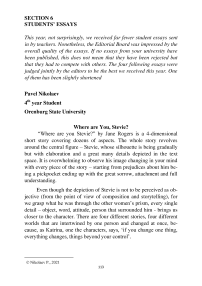Where are you, Stevie?
Автор: Nikolaev Pavel
Журнал: Тропа. Современная британская литература в российских вузах @footpath
Рубрика: Students' essays
Статья в выпуске: 14, 2021 года.
Бесплатный доступ
Короткий адрес: https://sciup.org/147235580
IDR: 147235580
Текст статьи Where are you, Stevie?
“Where are you Stevie?” by Jane Rogers is a 4-dimensional short story covering dozens of aspects. The whole story revolves around the central figure – Stevie, whose silhouette is being gradually but with elaboration and a great many details depicted in the text space. It is overwhelming to observe his image changing in your mind with every piece of the story – starting from prejudices about him being a pickpocket ending up with the great sorrow, attachment and full understanding.
Even though the depiction of Stevie is not to be perceived as objective (from the point of view of composition and storytelling), for we grasp what he was through the other women’s prism, every single detail – object, word, attitude, person that surrounded him - brings us closer to the character. There are four different stories, four different worlds that are intertwined by one person and changed at once, because, as Katrina, one the characters, says, ‘if you change one thing, everything changes, things beyond your control’.
What helped the author to create such an intricate portrait of the character that forms our (I believe, positive) attitude towards Stevie? Firstly, the description of the family and the nature that surrounded him. Jane Rogers dwells upon a crucial issue of the role of the family in the person formation process. The author displays the history of several generations at the same time. We first get to know what Stevie’s grandparents and mother were like, how their relationship was built and what impact it had upon Stevie. Getting a child at an early age, Stevie’s mother got strongly criticized by the parents. Being called names and stickered as “filthy little slut”, “mucky little tramp”, “once a slut always a slut” instead of being supported at the significant life stage – was she, a child herself, strong and courageous enough then to grow up as a decent and diligent person? Did she have chances not to end up in a surrounding of ‘ bottles. Cans. Filth ’ without her parents’ help? A question to debate. At the same time, though, the matter of the person’s nature arises. Did the situation, that Stevie lived with his mother in, spoil the boy? Controversy shows up again. On the one hand, we get to know that the boy ended up in juvenile court for theft, people perceive him as a “ bad lot ”, he smells like “ stale alcohol ” and after all he died of “ accidental overdose ”. On the other hand – through the reminiscences of the depicted characters, we learn “ he liked to sit on the back step at night, watching the sky, waiting for a shooting star ”, he cared about his mum a lot, for he constantly said he couldn’t leave her on her own, he has to do difficult and tiring jobs to make ends meet while studying and being quite clever and totally fascinated by electronics. Not only deep inside, for himself, was he a beautiful person but also with the other people, which we witness in the last chapter.
Social matters, though not being a central topic, can also be discussed in the framework of this short story. More precisely, how the society judges the people by the outer features not knowing the entire life story of theirs’. Does the society, ordinary people, give a try to socialize and treat fairly those who has gone the wrong path? Do people express mercifulness – not only at the Christmas time but on the other days as well? In what state is the society now? The constant will to stop hearing the Christmas jingles, to stop hearing calls like ‘ have-yourself-a-merry-little-Xmas-Let-your-heart-be-light ’, to block the 114
world by earplugs, and just several words of Amanda, the heroine of the first chapter, are to be an attempt to answer these questions – ‘ what on Earth is wrong with me? Who are these tears for? ’, ‘ I seem – I seem to have forgotten what kindness is ’.
One of the major themes of the story is death and humans’ attitude towards it. The most detailed and realistic psychological portrait that makes you first feel irritated but then totally understanding and sympathizing is the Lisa’s one. She still cannot fully realize what this loss means to her. She tells herself ‘ he wasn’t worth her tears ’, she’s ‘ heartless’ and she ‘ doesn’t care what happens to anyone ’. But then she changes her mind as if being on a rollercoaster – she wants to know what the death means, where Stevie is now. She believes that ‘ nothing vanishes: he’s up there with all of that stuff he likes ’ and contemplates if her friend’s death was her fault. Up and down, up and down do we follow her reflections floundering and getting tangled – this manner of narration can be noted as a masterful one.
Of utmost significance is the last chapter told by Katrina, who sums up the whole piece saying ‘there is a balance between loss and gain, and gain is found in loss’ as well reminding both herself and the reader that ‘ in seven years no bit of me will be the same as it is now, whether I want it to change or not. Only the dead can’t change ’. What does it exactly mean? What sense does it all have? It is up to the reader to decide and find his or her own meanings.


